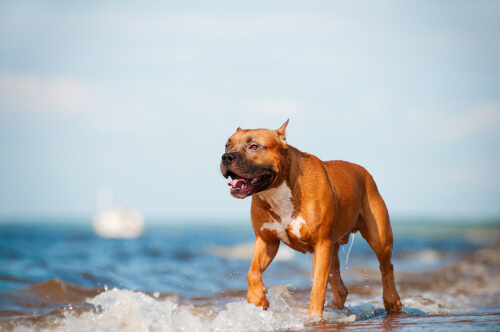Why Is It Dangerous to Cut off a Dog's Tail?


Written and verified by the psychologist Sara González Juárez
Although it may seem crazy, aesthetics also exists in the canine world, leading many people to forget that it’s dangerous to cut off a dog’s tail. The pain it causes, as well as the complications, have been proved by veterinarians around the world.
Therefore, to reiterate once again how unnecessary this habit is, we’re going to take a look at how dangerous it is to cut off a dog’s tail and what it means for the animal’s health. Don’t miss a thing, as this is such an important topic.
How is a cosmetic amputation of a dog’s tail performed?

The tail isn’t just a limb made of muscle and bone. The coccygeal vertebrae that form it are an extension of the dog’s spinal column, so it contains a complex system of muscles, tendons, blood vessels and nerves.
However, as a caudectomy is an operation that is performed a few days after the dog’s birth, quite often the cut is made without anesthesia of any kind and using totally inadequate tools (scissors, knives…). Another method people use is to place a very tight rubber band at the desired cutting height, so that the circulation is cut off and the tail falls off by itself after a few days.
The breeders and veterinarians who don’t use anesthesia argue that the puppies don’t feel pain because they’re too young.
Dangers of this procedure
As you can see, the procedure itself is a matter of debate. Even if anesthesia is used during the procedure (which in itself poses a risk to the dog), it’s a highly irrigated and innervated area. This means that intense pain is guaranteed, but it also opens the door to bleeding, cardiac difficulties, or convulsions.
Why is it dangerous to cut off a dog’s tail?
As you have seen in this brief description of the intervention, it’s easy to see that this procedure is highly dangerous for dogs. However, the postoperative period also brings risks for the animal and can cause it problems throughout its life. Let’s take a look at the most serious implications.
The complicated postoperative period
Assuming the amputation is carried out correctly, the subsequent recovery will be complicated and painful. There’s also a high risk of pyoderma (purulent skin infection) on the resulting stump.
Compromised mobility
A dog’s tail is like its rudder, the counterweight that allows it to maintain its balance when it twists and turns as it runs. Thanks to this, they are able to carry out movements that they would otherwise not be able to do or find more difficult to perform.
Chronic pain
If postoperative pyoderma has developed or subsequent infections of the residual limb occur, it’s much more likely that the dog will suffer constant chronic pain. Likewise, this pain will also be chronic when neuromas develop after the caudectomy.
Pain is difficult to quantify, especially in animals. However, several studies have evaluated dogs’ physiological reactions to painful stimuli, confirming pain even when the dog doesn’t show it.
It’s also dangerous to cut off a dog’s tail because of the risk of atrophy
Several muscles that connect to the pelvis are involved in tail movements. Therefore, restricting or eliminating this mobility will negatively affect the animal’s pelvic area. Muscle atrophy, bone degeneration, or even fecal incontinence are likely consequences as the animal with a docked tail approaches old age.
Communication problems
Last but not least, the importance of the tail in dog communication should be taken into account. Both among their own kind and with humans, the absence of the information transmitted by the tail leads to misunderstandings when interpreting their emotions and intentions.
Something as simple as wagging their tail means that we won’t know if the dog is nervous or happy. This is awkward when it comes to communication with other dogs, where these misunderstandings sometimes lead to conflicts and fights.
The never-ending fight against aesthetic amputation

Caudectomy is just one example of amputations performed on animals for aesthetics and other interests. Declawing in cats, as well as the removal of fangs or the cutting of vocal cords, are still pending issues in the fight for animal rights.
So, if you ever wondered whether it’s dangerous to cut off a dog’s tail, ask a human amputee what life is like without a certain part of their body. And then ask yourself what it would mean to do it for aesthetics.
Responsibility to others, humans or not, should take precedence over any aesthetic preference.
Although it may seem crazy, aesthetics also exists in the canine world, leading many people to forget that it’s dangerous to cut off a dog’s tail. The pain it causes, as well as the complications, have been proved by veterinarians around the world.
Therefore, to reiterate once again how unnecessary this habit is, we’re going to take a look at how dangerous it is to cut off a dog’s tail and what it means for the animal’s health. Don’t miss a thing, as this is such an important topic.
How is a cosmetic amputation of a dog’s tail performed?

The tail isn’t just a limb made of muscle and bone. The coccygeal vertebrae that form it are an extension of the dog’s spinal column, so it contains a complex system of muscles, tendons, blood vessels and nerves.
However, as a caudectomy is an operation that is performed a few days after the dog’s birth, quite often the cut is made without anesthesia of any kind and using totally inadequate tools (scissors, knives…). Another method people use is to place a very tight rubber band at the desired cutting height, so that the circulation is cut off and the tail falls off by itself after a few days.
The breeders and veterinarians who don’t use anesthesia argue that the puppies don’t feel pain because they’re too young.
Dangers of this procedure
As you can see, the procedure itself is a matter of debate. Even if anesthesia is used during the procedure (which in itself poses a risk to the dog), it’s a highly irrigated and innervated area. This means that intense pain is guaranteed, but it also opens the door to bleeding, cardiac difficulties, or convulsions.
Why is it dangerous to cut off a dog’s tail?
As you have seen in this brief description of the intervention, it’s easy to see that this procedure is highly dangerous for dogs. However, the postoperative period also brings risks for the animal and can cause it problems throughout its life. Let’s take a look at the most serious implications.
The complicated postoperative period
Assuming the amputation is carried out correctly, the subsequent recovery will be complicated and painful. There’s also a high risk of pyoderma (purulent skin infection) on the resulting stump.
Compromised mobility
A dog’s tail is like its rudder, the counterweight that allows it to maintain its balance when it twists and turns as it runs. Thanks to this, they are able to carry out movements that they would otherwise not be able to do or find more difficult to perform.
Chronic pain
If postoperative pyoderma has developed or subsequent infections of the residual limb occur, it’s much more likely that the dog will suffer constant chronic pain. Likewise, this pain will also be chronic when neuromas develop after the caudectomy.
Pain is difficult to quantify, especially in animals. However, several studies have evaluated dogs’ physiological reactions to painful stimuli, confirming pain even when the dog doesn’t show it.
It’s also dangerous to cut off a dog’s tail because of the risk of atrophy
Several muscles that connect to the pelvis are involved in tail movements. Therefore, restricting or eliminating this mobility will negatively affect the animal’s pelvic area. Muscle atrophy, bone degeneration, or even fecal incontinence are likely consequences as the animal with a docked tail approaches old age.
Communication problems
Last but not least, the importance of the tail in dog communication should be taken into account. Both among their own kind and with humans, the absence of the information transmitted by the tail leads to misunderstandings when interpreting their emotions and intentions.
Something as simple as wagging their tail means that we won’t know if the dog is nervous or happy. This is awkward when it comes to communication with other dogs, where these misunderstandings sometimes lead to conflicts and fights.
The never-ending fight against aesthetic amputation

Caudectomy is just one example of amputations performed on animals for aesthetics and other interests. Declawing in cats, as well as the removal of fangs or the cutting of vocal cords, are still pending issues in the fight for animal rights.
So, if you ever wondered whether it’s dangerous to cut off a dog’s tail, ask a human amputee what life is like without a certain part of their body. And then ask yourself what it would mean to do it for aesthetics.
Responsibility to others, humans or not, should take precedence over any aesthetic preference.
All cited sources were thoroughly reviewed by our team to ensure their quality, reliability, currency, and validity. The bibliography of this article was considered reliable and of academic or scientific accuracy.
- Modificaciones Conductuales y Aspectos Éticos del Corte de Cola (Caudectomia) en Perros: Ventajas y Desventajas. (2020, 15 enero). BMeditores. Recuperado 23 de marzo de 2023, de https://bmeditores.mx/secciones-especiales/modificaciones-conductuales-y-aspectos-eticos-del-corte-de-cola-caudectomia-en-perros-ventajas-y-desventajas/
- A. (2021, 15 septiembre). Informe veterinario sobre las amputaciones estéticas en la especie canina. WordPress.com. https://avatma.org/2016/02/08/informe-veterinario-sobre-las-amputaciones-esteticas-en-la-especia-canina/
- Bennett, P. C., & Perini, E. (2003). Tail docking in dogs: a review of the issues. Australian Veterinary Journal, 81(4), 208-218.
- Reyes-Sotelo, B., Mota-Rojas, D., Martínez-Burnes, J., Gómez, J., Lezama, K., González-Lozano, M., … & Mora-Medina, P. (2020). Tail docking in dogs: Behavioural, physiological and ethical aspects. CABI Reviews, (2020).
This text is provided for informational purposes only and does not replace consultation with a professional. If in doubt, consult your specialist.








